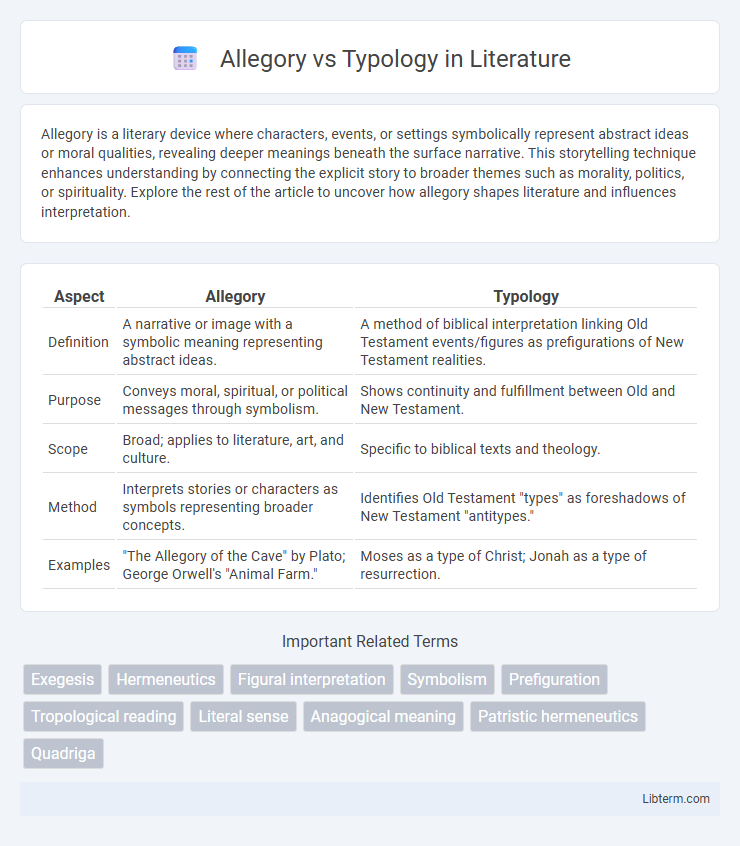Allegory is a literary device where characters, events, or settings symbolically represent abstract ideas or moral qualities, revealing deeper meanings beneath the surface narrative. This storytelling technique enhances understanding by connecting the explicit story to broader themes such as morality, politics, or spirituality. Explore the rest of the article to uncover how allegory shapes literature and influences interpretation.
Table of Comparison
| Aspect | Allegory | Typology |
|---|---|---|
| Definition | A narrative or image with a symbolic meaning representing abstract ideas. | A method of biblical interpretation linking Old Testament events/figures as prefigurations of New Testament realities. |
| Purpose | Conveys moral, spiritual, or political messages through symbolism. | Shows continuity and fulfillment between Old and New Testament. |
| Scope | Broad; applies to literature, art, and culture. | Specific to biblical texts and theology. |
| Method | Interprets stories or characters as symbols representing broader concepts. | Identifies Old Testament "types" as foreshadows of New Testament "antitypes." |
| Examples | "The Allegory of the Cave" by Plato; George Orwell's "Animal Farm." | Moses as a type of Christ; Jonah as a type of resurrection. |
Introduction to Allegory and Typology
Allegory is a literary device where characters, events, or settings symbolize abstract ideas, conveying deeper moral or spiritual meanings beyond the literal narrative. Typology refers to a theological interpretive method in which elements from the Old Testament are seen as prefigurations or "types" of Christ and events in the New Testament. Both allegory and typology enrich scriptural understanding by revealing layered meanings that connect historical texts with broader spiritual truths.
Defining Allegory: Meaning and Features
Allegory is a literary and artistic device where characters, events, or narratives symbolize broader moral, spiritual, or political meanings beyond their literal sense. It features a dual-layered interpretation, with the surface story representing an abstract idea or principle that invites readers to uncover hidden truths. This method fosters deeper understanding by linking concrete elements to universal concepts, often used in religious texts, literature, and art.
Understanding Typology: Key Characteristics
Typology in biblical studies emphasizes prefiguring events, persons, or institutions in the Old Testament that find their fulfillment in the New Testament, highlighting a divinely orchestrated pattern of salvation history. It is characterized by a direct, intentional correlation where the "type" (Old Testament figure or event) foreshadows the "antitype" (New Testament fulfillment) with theological significance. Unlike allegory, typology maintains a concrete historical foundation, ensuring that meanings are grounded in actual biblical events rather than abstract interpretations.
Historical Origins of Allegory and Typology
Allegory originated in ancient Greek philosophy, particularly in the works of Plato, who used symbolic storytelling to convey deeper moral and metaphysical meanings beyond literal events. Typology, by contrast, emerged within early Christian exegesis, interpreting Old Testament events as prefigurations or "types" that foreshadow New Testament realities. Both allegory and typology developed as methods to uncover spiritual significance in texts, but typology is distinct in its direct prophetic relationship between historical events and Christian doctrine.
Allegory in Literature and Theology
Allegory in literature and theology functions as a symbolic narrative technique where characters, events, or settings represent abstract ideas or moral qualities, creating multiple layers of meaning. This method enables writers and theologians to convey complex spiritual truths and ethical lessons through metaphorical storytelling, often enhancing interpretative depth. Unlike typology, which links Old Testament events with New Testament fulfillments, allegory emphasizes broader symbolic representation across texts.
Typology in Biblical Interpretation
Typology in biblical interpretation identifies Old Testament events, persons, or institutions as prefigurations of New Testament revelations, revealing God's unfolding plan of salvation through divinely inspired patterns. This method emphasizes the interconnectedness of Scripture, where types serve as prophetic symbols pointing directly to Christ's life, death, and resurrection. As a theological framework, typology enriches biblical understanding by linking historical fulfillment with spiritual significance rooted in divine revelation.
Core Differences Between Allegory and Typology
Allegory interprets a narrative or image by assigning symbolic meanings that often extend beyond the original context, creating multiple layers of abstract representation. Typology identifies specific events, persons, or institutions in the Old Testament as prefigurations or foreshadowings of New Testament realities, emphasizing a divinely intended correspondence. The core difference lies in allegory's flexible, interpretive symbolism versus typology's structured, prophetic linkage within theological frameworks.
Similarities and Overlaps
Allegory and typology both interpret biblical texts by revealing deeper spiritual meanings beyond the literal sense, often connecting Old Testament events or figures with New Testament fulfillments. They share a common method of finding symbolic significance, where allegory uses broader symbolic narratives while typology emphasizes concrete foreshadowings or prefigurations of Christ and salvation history. Both approaches overlap in their use of scripture to convey theological truths and reinforce continuity within the biblical canon.
Allegory vs Typology: Examples in Practice
Allegory interprets biblical narratives as symbolic stories with moral or spiritual meanings, such as the Good Samaritan representing universal compassion beyond literal events. Typology identifies specific persons, events, or institutions in the Old Testament as prefigurations of New Testament realities, exemplified by Moses as a type of Christ leading salvation. In practice, allegory emphasizes broader thematic lessons, while typology highlights direct prophetic or covenantal connections between Testaments.
Conclusion: Choosing the Right Approach
Choosing between allegory and typology depends on interpretive goals and textual context. Allegory emphasizes symbolic meanings transcending literal narratives, while typology highlights prefigured connections within scripture, reinforcing theological continuity. Understanding the distinctive purposes of each method ensures more accurate and meaningful biblical exegesis.
Allegory Infographic

 libterm.com
libterm.com